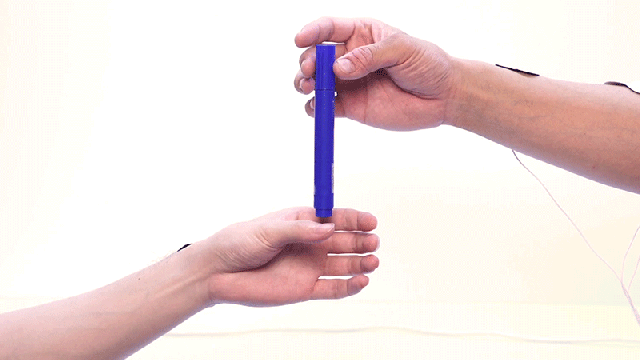It’s hard not to be envious of Spider-Man’s ability to dodge attacks using his superhuman reflexes when you still drop your toast on the floor some mornings. But a radioactive spider bite might not be the only way to gain superhuman reflexes. Researchers have demonstrated a method of super-charging human reflexes by using a combination of sensors and well-timed electrical muscle stimulation.
[referenced url=”https://gizmodo.com.au/2019/01/samsung-let-me-wear-an-exoskeleton-and-i-liked-it/” thumb=”https://i.kinja-img.com/gawker-media/image/upload/t_ku-large/jigrf9u6pzypmrbkyvlo.jpg” title=”Samsung Let Me Wear An Exoskeleton, And I Liked It” excerpt=”When a lot of people picture an exoskeleton, they might imagine Matt Damon wearing a robotic jumpsuit of sorts in the entertaining but critically panned move Elysium. Samsung has a different idea for how this technology might work. At the Consumer Electronics Show (CES) in Las Vegas, the company showed off a line of exoskeleton concepts. They’re sleek, lightweight, and as far I know, do not require screwing anything into your spine. This is a future I can get behind!”]
The average human can react to a visual stimulus in about a quarter of a second, so when your eyes notice a mosquito buzzing around your head, it takes about 250 milliseconds for your arm to raise and swat it away.
Your brain spends the majority of that time — about 200 milliseconds — processing what it sees, deciding what to do, and then sending a signal for your body to react. The last 50 milliseconds is how long it takes for a human muscle to actually spring into action when it’s told to.
The combination of the two processes represents a human’s reaction time, and researchers at the University of Chicago and the Sony CSL research lab in Tokyo, Japan, have devised a rudimentary way of chopping down that baseline reaction time.
In a series of simple experiments that involved catching a dropped marker, photographing a high-speed object in motion, and shooting a baseball out of the air, the researchers used a combination of sensors to detect the event and connected electrical muscle stimulators to trigger a reaction in the subject.
The goal of the research, however, wasn’t to make the subjects feel like puppets being controlled by the hardware. Would you really feel like a superhero if you were just along for the ride while somebody was remotely controlling your body? Not at all.
Through trial and error, the researchers found that by limiting the activation of the electrical muscle stimulators to around 160 milliseconds after the trigger event, a subject’s reaction times could be sped up by almost 80 milliseconds while still making them feel as though they were in complete control of their bodies.
In reality, their movements were completely controlled by the all the hardware they were wired into, but because they were concentrating on the same task during the experiment, the timing between their natural reactions and the artificially triggered ones was close enough to fool them into thinking they had done it themselves.
The idea of slipping into a special suit that enhanced the wearer’s reflexes is a tantalising one for comic book fans, but the research has a long way to go before vigilantes with bonafide superpowers will be roaming the streets.
The experiments were limited to a very specific and single event. If the test subjects had changed their minds at the last minute it wouldn’t have made any differences, their reactions would have been the same. The system would have to take into account a near-unlimited number of variables and stimuli to be truly effective and replicate something like Spider-Man’s spidey-sense.
Free-ranging superhuman powers are still a far-off dream, but the approach could be beneficial to those dealing with mobility challenges who rely on technology, such as electrical muscle stimulation, to improve their daily lives.
Those tasks, such as safely walking around a room without stepping on or tripping over obstacles, greatly reduce the number of variables that need to be accounted for. This research could make it easier and safer for persons with disabilities to get around, while still giving them a strong sense of independence.
